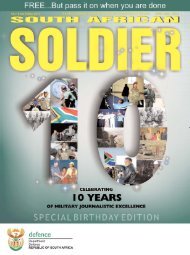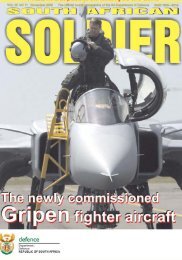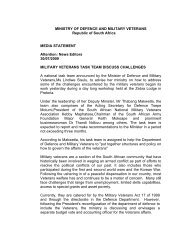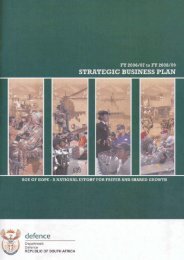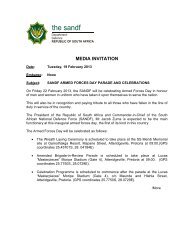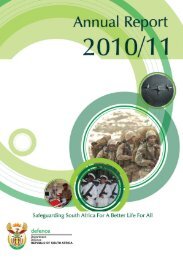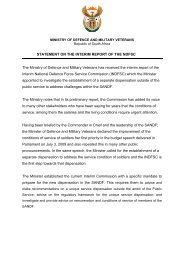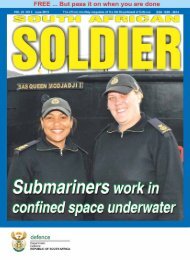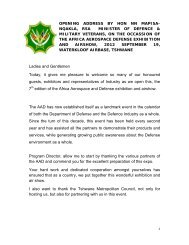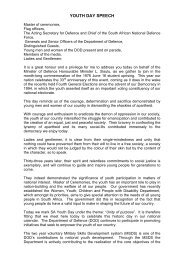Chapter 2 - P rogramme 1 - Department of Defence
Chapter 2 - P rogramme 1 - Department of Defence
Chapter 2 - P rogramme 1 - Department of Defence
Create successful ePaper yourself
Turn your PDF publications into a flip-book with our unique Google optimized e-Paper software.
| <strong>Chapter</strong> 4 - P<strong>rogramme</strong> 2: Landward <strong>Defence</strong> |<br />
40% female candidates were not achieved as only 2%<br />
and 32% in the respective categories were accepted<br />
into the MSDS p<strong>rogramme</strong>.<br />
The challenges faced in terms <strong>of</strong> sustainment were<br />
addressed through various initiatives. The continued<br />
employment <strong>of</strong> an Industrial Support Concept<br />
for Engineer C Vehicles in the DRC ensured that<br />
the vehicles maintained the highest percentage <strong>of</strong><br />
serviceability and availability <strong>of</strong> all SANDF prime<br />
mission equipment. The Apex Base, home <strong>of</strong> ADA<br />
Reserves in Gauteng, which accommodates both<br />
Regular and Reserve courses, has been upgraded.<br />
The SA Army Engineers upgraded its own facilities<br />
at Bethlehem to enhance training <strong>of</strong> MSDS<br />
members and the SA Army contributed Rm22.4<br />
from its own budget to address occupational health<br />
and safety (OHS) requirements and facilities for its<br />
MSDS. The SA Army Engineer Formation was<br />
granted the mandate by the Ministry <strong>of</strong> <strong>Defence</strong><br />
to interact directly with the Engineering Council <strong>of</strong><br />
South Africa (ECSA) in an effort to recruit capacity<br />
in the scarce skills environment <strong>of</strong> engineering.<br />
Remarkable progress was made in the human<br />
resources complement, in efforts to rebuild the<br />
Technical Service Corps Reserve units. During the<br />
past year, a total <strong>of</strong> 91 members entered this Corps,<br />
mainly by converting from the Army Territorial<br />
Reserve to the Conventional Reserve.<br />
Army social responsibility initiatives to assist in<br />
reskilling members leaving the Service have also<br />
borne fruit. A total <strong>of</strong> 233 members successfully<br />
completed their Code 8 licence training and were<br />
transferred to the SAPS on 30 December 2007.<br />
An initial first contract was successfully negotiated<br />
with Imperial Holdings (Fleet Services) to train 500<br />
Regular volunteers for the public/private transport<br />
industry towards a Code 14 heavy-duty driver’s<br />
licence. The contract stipulates that the 500 members<br />
must be provided over a period <strong>of</strong> five years. The first<br />
pilot group <strong>of</strong> 31 volunteers commenced with their<br />
training on 15 November 2007 at 9 SAI Battalion.<br />
Liaison also took place with a private engineering<br />
company, Molukutho Engineering, with regard to a<br />
reskilling opportunity and employment on <strong>of</strong>fshore<br />
oil rigs. The SA Army will provide the facilities,<br />
whilst the engineering company will provide the<br />
equipment and training.<br />
As previously reported, facilities and equipment are<br />
in a state <strong>of</strong> decline due to the cost <strong>of</strong> maintenance<br />
and repair and extended lifecycle use, amongst<br />
other factors. Rm22 <strong>of</strong> the Army operating funds<br />
was utilised in the facility’s recoverable environment<br />
Annual Report FY 2007 - 2008 104<br />
| <strong>Department</strong> <strong>of</strong> <strong>Defence</strong> |<br />
and limited amounts were utilised in the day-today<br />
maintenance. Various alternatives are being<br />
considered to address this situation, <strong>of</strong> which the<br />
allocation <strong>of</strong> additional funding by Parliament in<br />
future years to modernise the Landward <strong>Defence</strong><br />
P<strong>rogramme</strong> is an overriding option. In preparation<br />
for this eventuality, and in order to ensure that such<br />
funding is used optimally and directed at the required<br />
landward defence needs, several expert seminars<br />
were held during the past year. Of note is the South<br />
African Army Seminar 21, held in February 2008.<br />
The seminar explored the landward capability and<br />
was aimed at conducting a future-oriented analysis<br />
to explore international and regional trends/threats/<br />
realities and their impact on peace, conflict and<br />
war. The seminar included expert presenters from<br />
Africa and almost all other continents. Participants<br />
included members from the Portfolio Committee on<br />
<strong>Defence</strong>. In tandem with the theme, an informative<br />
Technology Workshop was held in March 2008,<br />
during which the validity <strong>of</strong> the current SA Army<br />
technology strategy was confirmed and new trends<br />
and their applicability to SA Army requirements<br />
were identified. A comprehensive strategic scenario<br />
planning session, with a multidisciplinary team<br />
comprising members from the SA Army, Reserve<br />
Force Council, the Portfolio Committee on <strong>Defence</strong><br />
and National Treasury, was also conducted during<br />
June 2007.<br />
Some supply, support and services functions could<br />
not be implemented within the SA Army during<br />
the last financial year (FY 2006/07) due to the<br />
lack <strong>of</strong> capacity to execute these functions. The<br />
SA Army has received certain logistic delegations<br />
from the Secretary for <strong>Defence</strong>, which will be<br />
fully implemented once the command and control<br />
channels have been clarified. Although procurement<br />
delegations have been received, they will only<br />
be implemented once training <strong>of</strong> procurement<br />
personnel has been completed. Self-accounting<br />
status allocation to units within the Army could not<br />
take place due to non-adherence to self-accounting<br />
status requirements, i.e. structures and capability.<br />
The SA Army was tasked to establish a “Works<br />
Regiment” on behalf <strong>of</strong> the DOD, as an initiative to<br />
improve the state <strong>of</strong> DOD facilities. A project team<br />
was established and is in the process <strong>of</strong> engaging<br />
the private sector to assist in the practical training<br />
phase <strong>of</strong> the members. One hundred members<br />
started training in January 2008 and another<br />
200 are scheduled to start training in July 2008.<br />
Additional funding <strong>of</strong> Rm178 for this initiative<br />
was made available for the three years commencing<br />
FY 2008/09.



